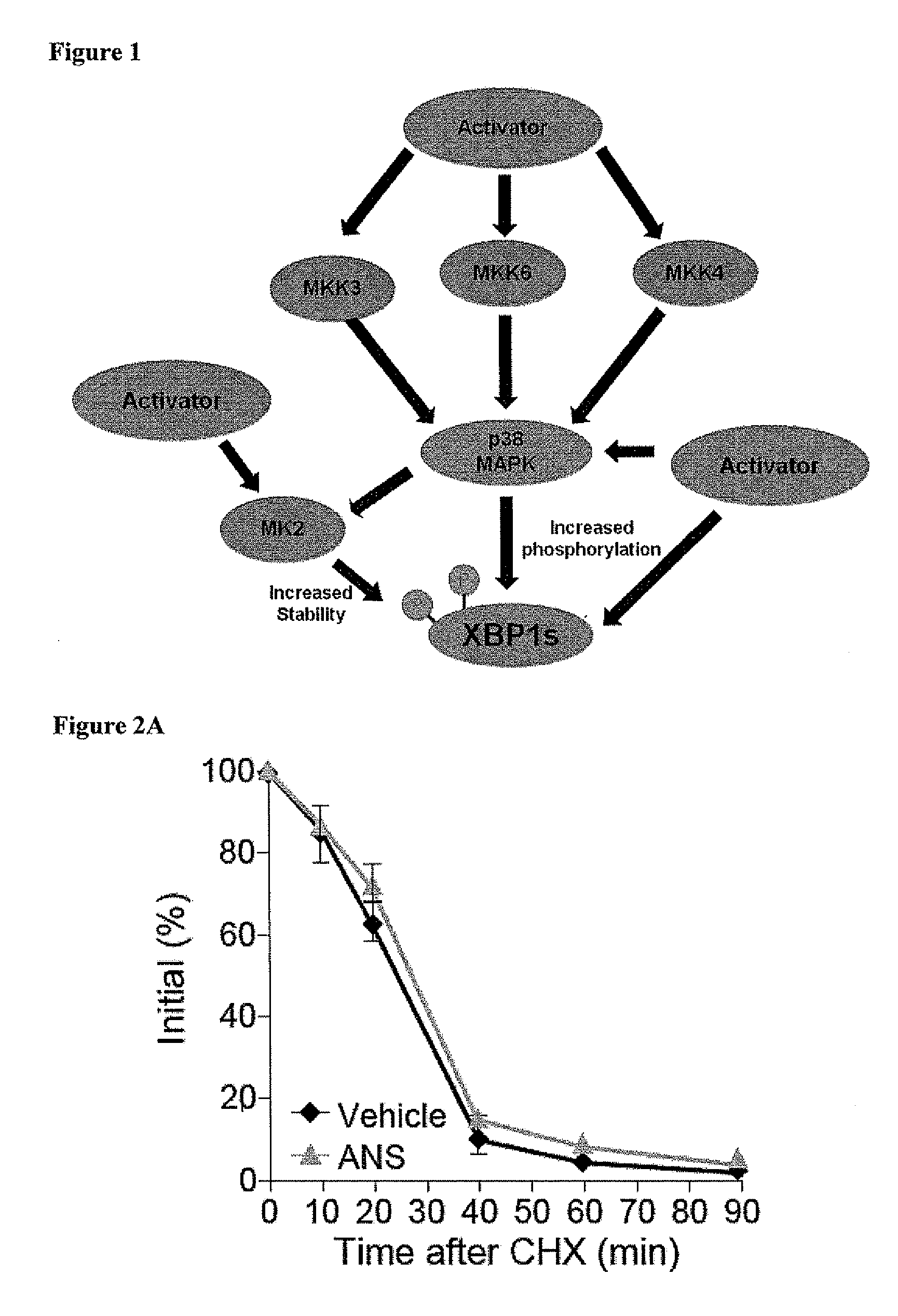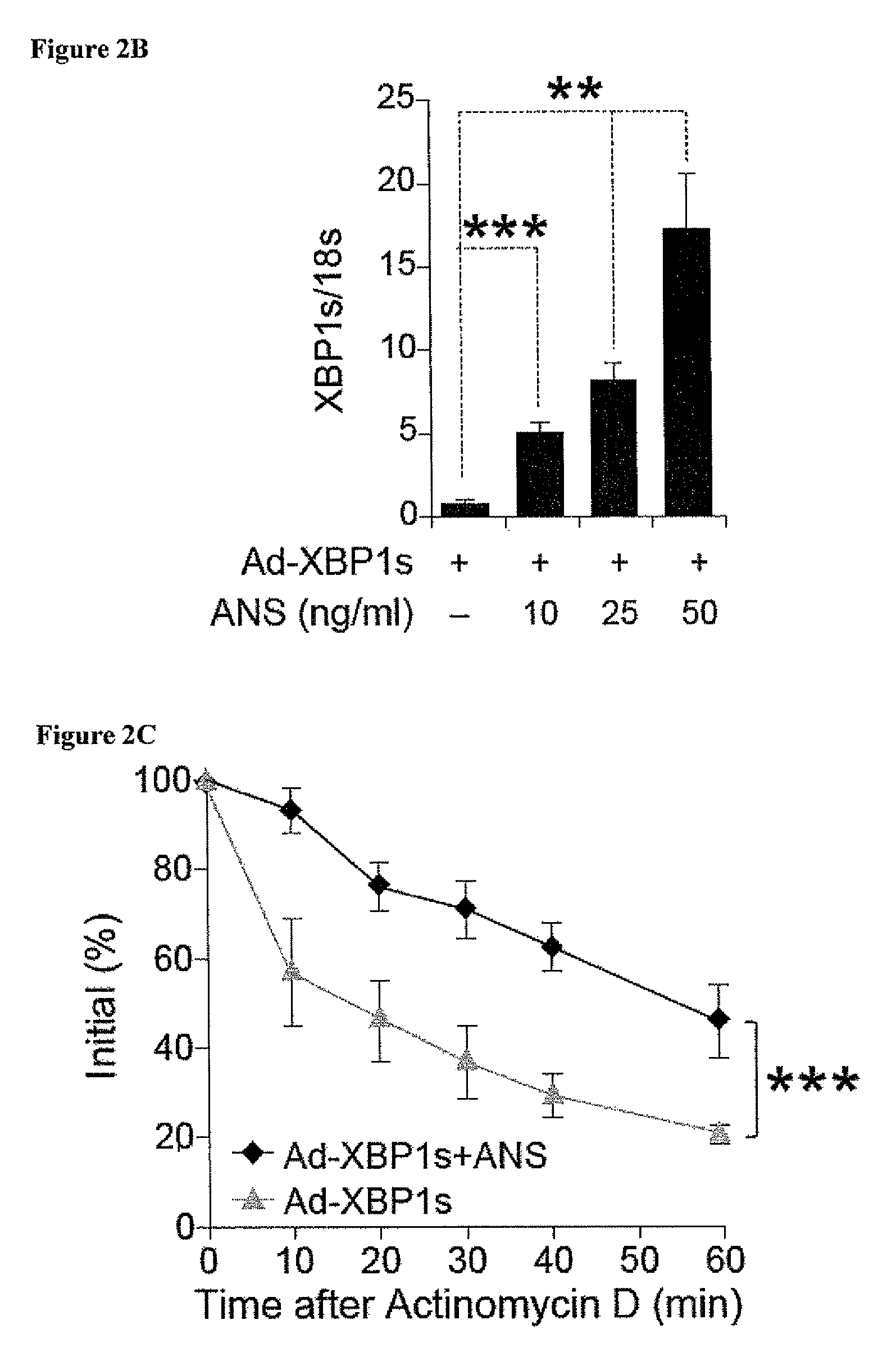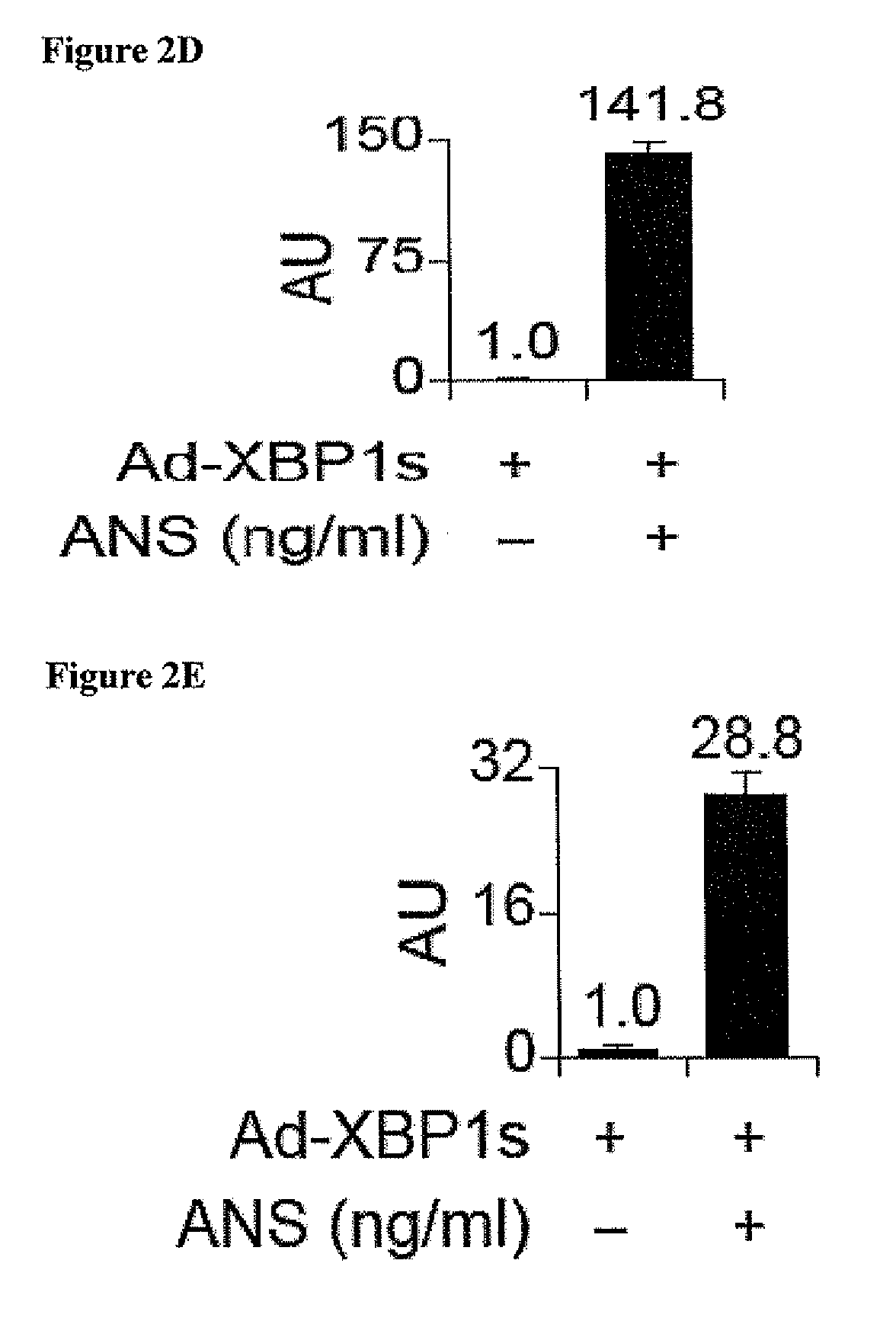Methods and compositions for reducing blood glucose
a technology of blood glucose and composition, applied in the field of metabolic homeostasis and insulin resistance, can solve the problems of unrecognized link between obesity and type 2 diabetes, few significant advances have been made in the last three decades in the therapeutic treatment of type 2 diabetes, etc., and achieve the effect of lowering blood glucose levels in obese patients
- Summary
- Abstract
- Description
- Claims
- Application Information
AI Technical Summary
Benefits of technology
Problems solved by technology
Method used
Image
Examples
example 1
SAPK Signaling Upregulates XBP1
[0150]Materials and Methods
[0151]Cell Culture
[0152]MEF cells were from American Type Tissue Collection (ATCC). These cells were grown in Dulbecco's Modified Eagle Medium (DMEM) supplemented with 10% fetal bovine serum (FBS), 10 U / ml penicillin and 1 μg / ml streptomycin at 37° C. and 5% CO2. Fao cells were maintained in RPMI 1640 medium (Invitrogen) supplemented with 10% fetal bovine serum (FBS), 10 U / ml penicillin and 1 μg / ml streptomycin.
[0153]Recombinant XBP1s
[0154]Recombinant XBP1s was produced at GenScript. XBP1s CDS together with 6×His-TF tag at N-terminal was cloned into pGSC1 plasmid. The sequences of His-IF tag (6×His+TF tag+3C protease cleavage site) are as follow:
[0155]
(SEQ ID NO: 1)MNHKVHHHHHHMQVSVETTQGLGRRVTITIAADSIETAVKSELVNVAKKVRIDGFRKGKVPMNIVAQRYGASVRQDVLGDLMSRNFIDAIIKEKINPAGAPTYVPGEYKLGEDFTYSVEFEVYPEVELQGLEAIEVEKPIVEVTDADVDGMLDTLRKQQATWKEKDGAVEAEDRVTIDFTGSVDGEEFEGGKASDFVLAMGQGRMIPGFEDGIKGHKAGEEFTIDVTFPEEYHAENLKGKAAKFAINLKKVEERELPELTAEFIK...
example 2
SAPK Signaling Increases XBP1 mRNA Stability Nuclear Translocation
[0168]Materials and Methods
[0169]Real-Time Quantitative PCR
[0170]Total RNA was extracted from cells or animal tissues using Trizol reagent (Invitrogen) and transcribed into cDNA using cDNA synthesis kit (Bio-Rad). The gene expression analysis was performed with iQ5 Multicolor Real-Time PCR Detection System (Bio-Rad) with SYBR Green Supermix (Bio-Rad). The mRNA level was normalized to 18S as a house keeping gene. The primer sequences used were:
[0171]
18S rRNA forward:(SEQ ID NO: 2)5′-AGT CCC TGC CCT TTG TAC ACA-3′;18S rRNA reverse:(SEQ ID NO: 3)5′-CGT TCC GAG GGC CTC ACT-3′;XBP1s forward:(SEQ ID NO: 4)5′-GGTCTGCTGAGTCCGCAGCAGG-3′;XBP1s reverse:(SEQ ID NO: 5)5′-AGGCTTGGTGTATACATGG-3′.
[0172]Cytoplasmic and Nuclear Protein Extraction
[0173]Cytoplasmic and nuclear protein fractions were extracted from cells by using nuclear protein extraction kit from Active Motif (Carlsbad, Calif.). Cells were maintained in 10 cm tissue cul...
example 3
XBP1 Upregulation Independent of JNK Activation
[0178]Materials and Methods
[0179]Plasmids
[0180]MKK7-JNK1-expressing plasmids were obtained from. Addgene (Cambridge, Mass.).
[0181]Results
[0182]To unravel the molecular mechanisms underlying the above observations, several different approaches were taken to explore whether activation of JNK, which is one of the most dominant signaling elements in SAPK signaling, affects XBP levels and nuclear translocation. First, Ad-LacZ-infected cells and Ad-XBP1s-infected cells were treated with a specific JNK inhibitor (JNK inhibitor VIII, 10 μM) for 30 minutes, then exposed to anisomycin (25 ng / ml) for two hours. The JNK inhibitor was effective in completely abolishing anisomycin-induced JNK activation (analyzed via c-Jun phosphorylation), but had no effect on anisomycin-mediated upregulation of XBP1s protein levels. As the second approach, JNK1 / 2− / − were stimulated with anisomycin, which also led to a significant increase in XBP1s protein that was ...
PUM
| Property | Measurement | Unit |
|---|---|---|
| melting point | aaaaa | aaaaa |
| weight | aaaaa | aaaaa |
| weight | aaaaa | aaaaa |
Abstract
Description
Claims
Application Information
 Login to View More
Login to View More - R&D
- Intellectual Property
- Life Sciences
- Materials
- Tech Scout
- Unparalleled Data Quality
- Higher Quality Content
- 60% Fewer Hallucinations
Browse by: Latest US Patents, China's latest patents, Technical Efficacy Thesaurus, Application Domain, Technology Topic, Popular Technical Reports.
© 2025 PatSnap. All rights reserved.Legal|Privacy policy|Modern Slavery Act Transparency Statement|Sitemap|About US| Contact US: help@patsnap.com



